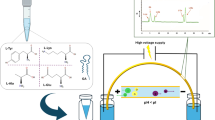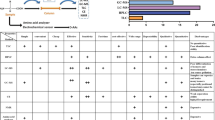Abstract
Coproporphyrinogen III oxidase is deficient in hereditary coproporphyria. An activity assay for this enzyme in mononuclear cells, besides the preparation of the substrate, are presented. The separation conditions for the product of the test protoporphyrin IX by gradient, reversed-phase high-performance liquid chromatography are given. The normal value from mononuclear cells of healthy volunteers was 138±21 pkat/g total soluble protein (mean±SD). The enzyme activity of a family with hereditary coproporphyria was measured. The gene carriers exhibit a specific coproporphyrinogen III oxidase activity of 61–90 pkat/g total soluble protein.
Similar content being viewed by others
REFERENCES
Boyum A (1984) Separation of lymphocytes, granulocytes, and monocytes from human blood using iodinated density gradient media. Methods Enzymol 108: 88–102.
Bradford MM (1976) A rapid and sensitive method for the quantitation of microgram quan-tities of protein utilizing the principle of protein dye binding. Anal Biochem 72: 248–254.
Doss MO, Gross U, Lamoril J, et al (1999) Compound heterozygous hereditary coproporphyria with fluorescing teeth. Ann Clin Biochem 36: 680–682.
Gray D, Golub SH (1984) Cryopreservation of lymphoid cells. Methods Enzymol 108: 363–367.
GroB U, Puy H, Kuihnel A, et al (2002a) Molecular, immunological, enzymatic and biochemi-cal studies of coproporphyrinogen oxidase deficiency in a family with hereditary coproporphyria. Cell Mol Biol 48: 49–55.
GroB U, Puy H, Meissauer U, et al (2002b) A molecular, enzymatic and clinical study in a family with hereditary coproporphyria. J Inherit Metab Dis 25: 279–286.
Guo R, Lim CK, Peters TJ (1988) Accurate and specific HPLC assay of coproporphyrinogen III oxidase activity in human peripheral leucocytes. Clin Chim Acta 177: 245–252.
Kuihnel A, GroB U, Doss MO (2000) Hereditary coproporphyria in Germany: clinical-biochemical studies in 53 patients. Clin Biochem 33: 465–473.
Layer G, Verfurth K, Mahlitz E, Jahn D (2002) Oxygen-independent coproporphyrinogen-III oxidase HemN from Escherichia coli. J Biol Chem 277: 34136–34142.
Martasek P (1998) Hereditary coproporphyria. Semin Liver Dis 18: 25–32.
Petersen NE, Kaehne M, Christiansen L, Brock A, Hother-Nielsen O, Rasmussen K (2000) DGGE analysis of the coproporphyrinogen oxidase gene: two new mutations in DNA from Danish patients with hereditary coproporphyria. Scand J Clin Lab Invest 60: 617–626.
Takeuchi H, Kondo M, Daimon M, et al (2001) Neonatal-onset hereditary coproporphyria with male pseudohermaphrodism. Blood 98: 3871–3873.
Author information
Authors and Affiliations
Rights and permissions
About this article
Cite this article
Gross, U., Gerlach, R., Kühnel, A. et al. A description of an HPLC assay of coproporphyrinogen III oxidase activity in mononuclear cells. J Inherit Metab Dis 26, 565–570 (2003). https://doi.org/10.1023/A:1025952031660
Issue Date:
DOI: https://doi.org/10.1023/A:1025952031660




